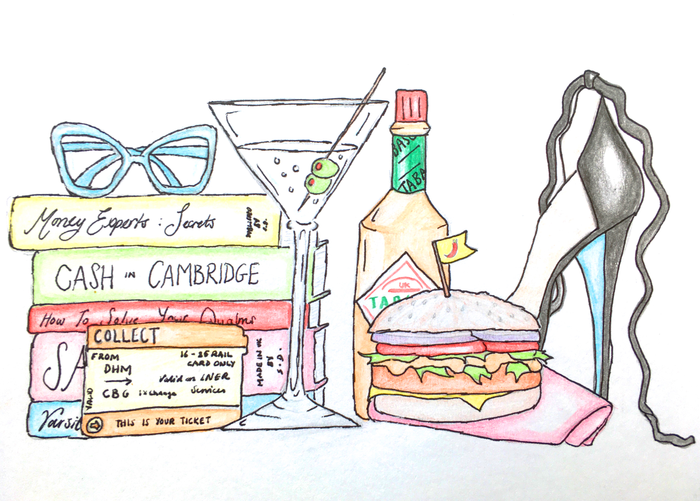Cambridge and the 21st-century gin craze
Phyllis Williams tests Cambridge gins, discovers the ‘molecular cocktail class’ and gin made with ants, and explores why gin is the drink of the century so far
Gin’s original reputation in Britain was wildly different from its current image. When gin first became popular (during the hazy gin craze of 1720-1751) it was predominantly associated with the poor.
As gin production grew more complicated and expensive, consumption began to be associated more with the rich. Since Britain was blessed by the glitzy Fever Tree Tonic as an alternative to Schweppes, gin has experienced a new wave of popularity in the 21st century. Along with the rise of the cocktail, gin has exploded into the colourful art form it is today.
There is no doubt the 21st-century gin craze has infiltrated Cambridge. ‘Gin’ is being used as a premium tag for various cultural events: ‘Gin & Jazz’ concerts, gin and punts’ tours, 'gin and cocktail’ bars. However, I believe Cambridge has brought its own slant onto the gin experience.
I’m thinking in particular of the Cambridge Gin Laboratory – a company I found out about through its tailored gins for colleges, using botanicals picked from college gardens.
The laboratory is a slanted little 18th-century building tucked within Green Street (near Sidney Sussex) dedicated to gin. The building is filled with much of the glass equipment you would expect to find in a chemistry laboratory: a rotary evaporator, beakers, volumetric flasks. There are dozens of glass bottles with botanicals infused in ethanol which you can spray into your mouth. Peeping into one of the back rooms I could also see a room with glass walls, covered in chemical formulas.
The shop changed my perception of what constitutes a botanical. Amongst their range is a gin made from distilled white truffle (Truffle Gin) and a gin containing approximately 62 distilled redwood ants per bottle (Anty Gin). Surprisingly, none of the gins were coloured.
Their scientific approach to gin is demonstrated in their ‘masterclass’, in particular the ‘molecular cocktail class’, which uses laboratory equipment and molecular gastronomy to learn about the science of gin and make complex gin cocktails, involving bubbles and colour changing solutions.
This alternative perspective on gin is contributing to the exciting culture of gin experimentation and I look forward to seeing where it will take the 21st-century gin craze.
Taste test
Cambridge Dry Gin, £39.99 - 9/10 - writer's best buy
- Ingredients: Juniper, fresh basil, rosemary, angelica, lemon verbena, blackcurrant leaf and rose petal
- Their flagship gin is closest to what I would expect an ordinary gin to taste like. Bitter juniper notes are still present but softened by floral notes giving it a smooth profile with a citrus tang.
Curators' Gin, £39.99 - 7/10
- Ingredients: Juniper, apples from Newton’s apple tree, cross pollinated rosemary-ginger and lavender-lemon plants
- These botanicals from the university Botanic Gardens give it an complex and herbaceous profile dominated by the lavender and rosemary. A real sensory surprise.
Japanese Gin, £65 - 9/10
- Ingredients: Juniper, shiso leaf, sesame seeds, cucumber, sansho and yuzu
- Dominating cucumber taste with subtle crisp notes from the Japanese botanicals which tingle my tongue. Wouldn’t want to have this one with tonic.
Truffle Gin, £80 - 4/10
- Ingredients: White truffle and juniper
- Very strong truffle aroma and a rich oily-buttery profile with deep lasting earthy notes. More of a sipping gin to have after a meal. Comes in a beautiful oily-black bottle.
Elderflower Gin liqueur, £29.99 - 8/10
- Ingredients: Elderflower added to Cambridge Dry Gin
- The sweetness of this disguises both the juniper and alcohol (21% ABV), making it wildly different from the ordinary gin profile and dangerously easy to drink neat. The strong flavour could easily be tempered by mixing it with tonic.
 News / Downing investigates ‘mysterious’ underground burial vault 29 December 2025
News / Downing investigates ‘mysterious’ underground burial vault 29 December 2025 News / Unions protest handling of redundancies at Epidemiology Unit30 December 2025
News / Unions protest handling of redundancies at Epidemiology Unit30 December 2025 Lifestyle / Ask Auntie Alice29 December 2025
Lifestyle / Ask Auntie Alice29 December 2025 Features / ‘Treated like we’re incompetent’: ents officers on college micromanagement30 December 2025
Features / ‘Treated like we’re incompetent’: ents officers on college micromanagement30 December 2025 Science / Astronomical events to look out for over the break29 December 2025
Science / Astronomical events to look out for over the break29 December 2025










